
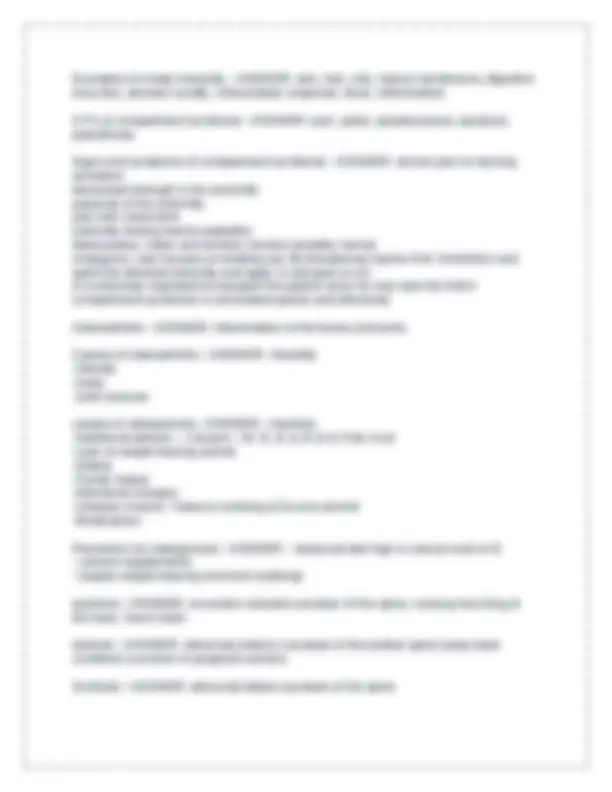
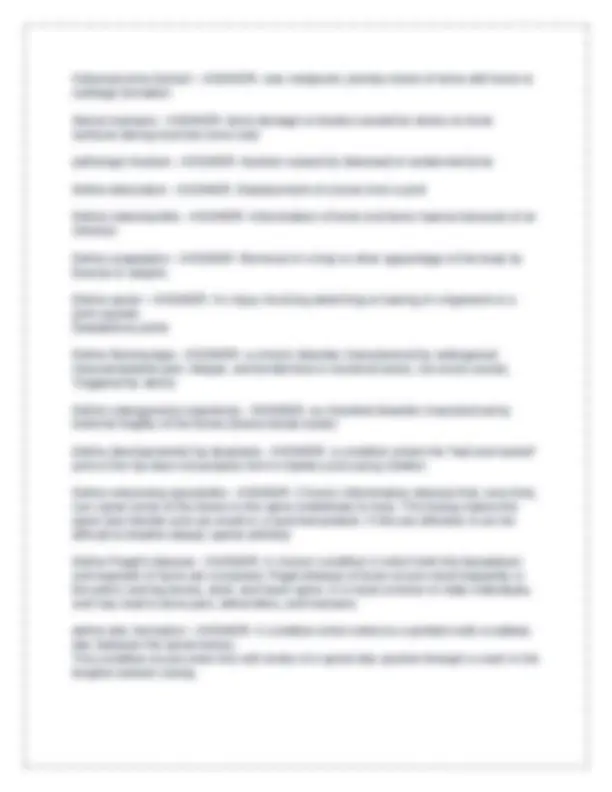
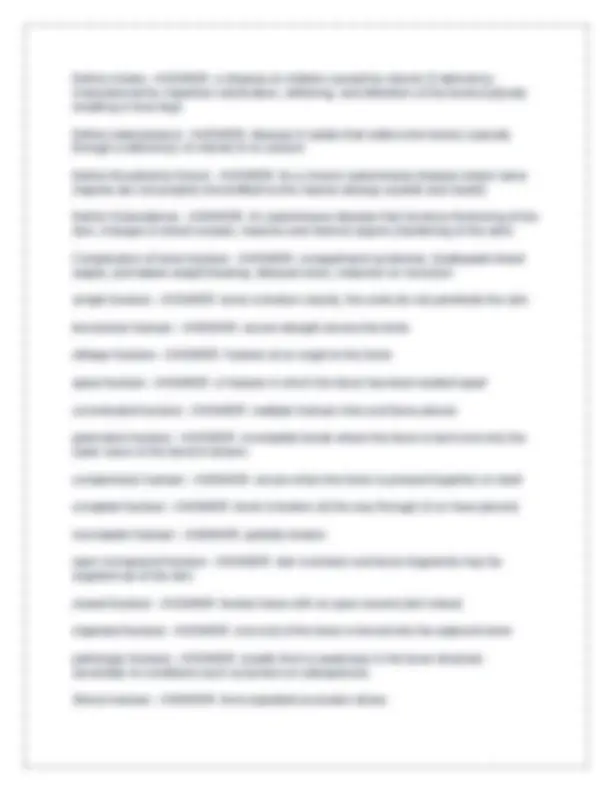
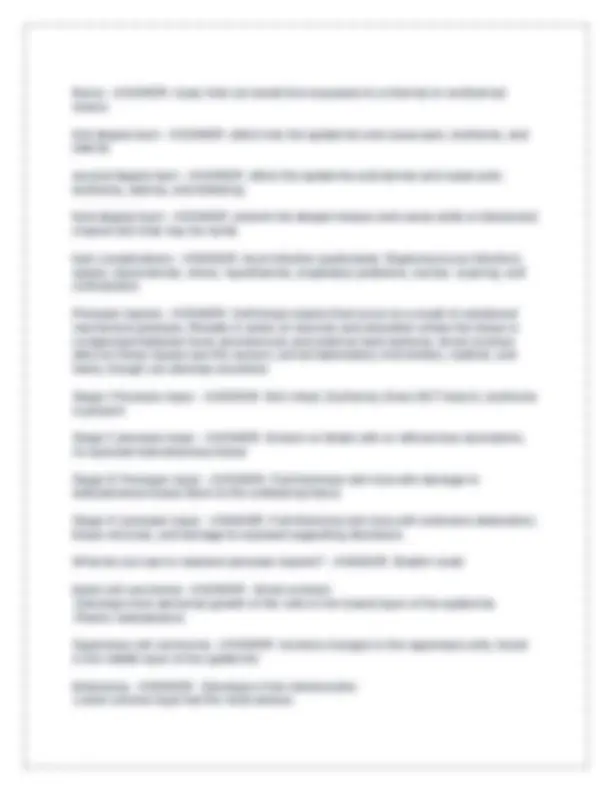
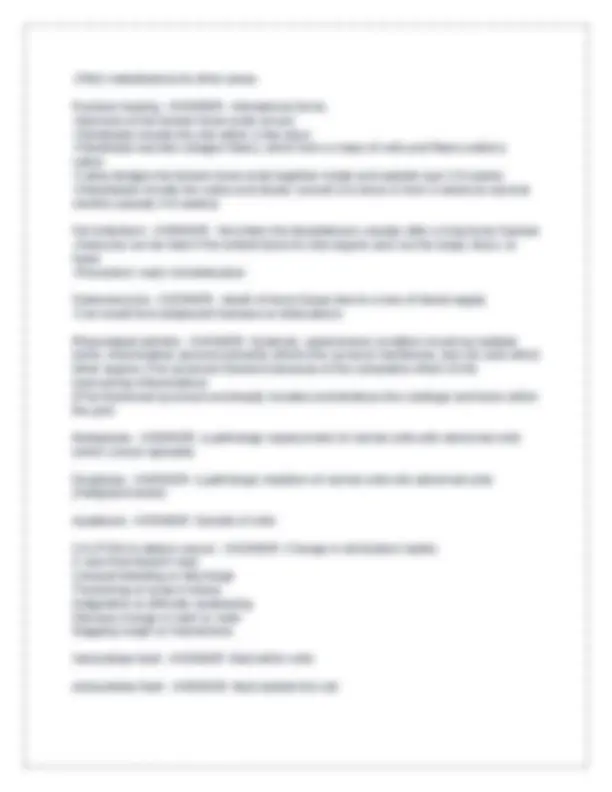
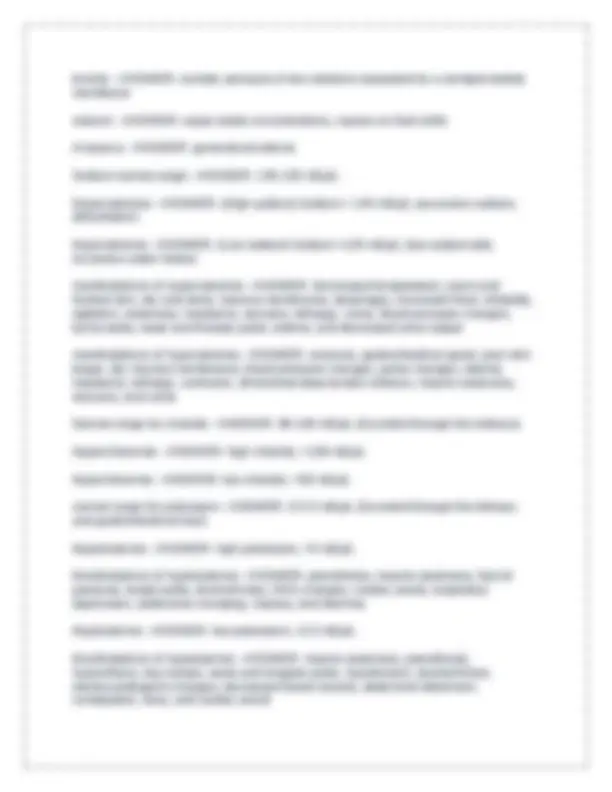
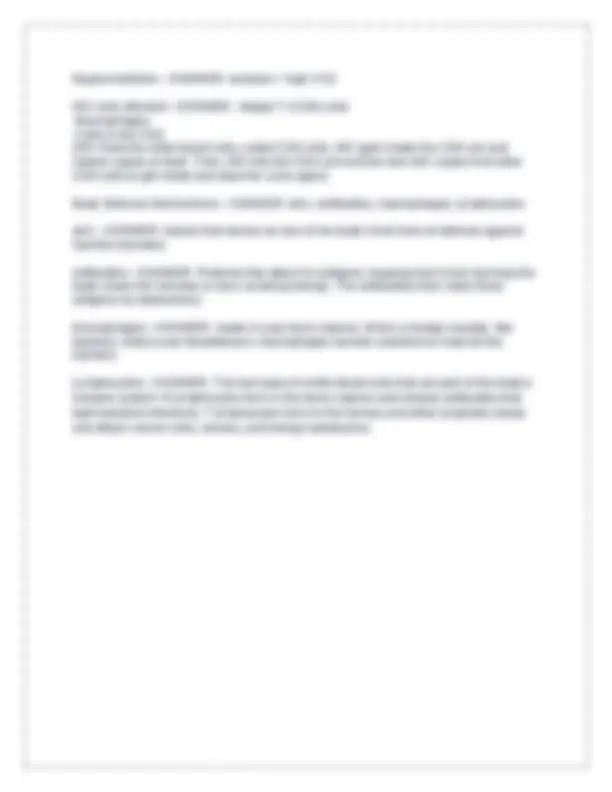


Study with the several resources on Docsity

Earn points by helping other students or get them with a premium plan


Prepare for your exams
Study with the several resources on Docsity

Earn points to download
Earn points by helping other students or get them with a premium plan
Community
Ask the community for help and clear up your study doubts
Discover the best universities in your country according to Docsity users
Free resources
Download our free guides on studying techniques, anxiety management strategies, and thesis advice from Docsity tutors
Rasmussen Pathophysiology Exam 1 Questions With 100% Correct Answers 2025..docx Rasmussen Pathophysiology Exam 2 Questions With Correct Detailed Answers..docx Pathophysiology Exam 1 Rasmussen Questions With Correct Answers..docx
Typology: Exams
1 / 13

This page cannot be seen from the preview
Don't miss anything!








function of mitochondria - ANSWER- ATP production/cellular respiration, powerhouse of the cell Rough ER - ANSWER- That portion of the endoplasmic reticulum studded with ribosomes. Smooth ER - ANSWER- That portion of the endoplasmic reticulum that is free of ribosomes. Homeostasis - ANSWER- A tendency to maintain a balanced or constant internal state; the regulation of any aspect of body chemistry, such as blood glucose, around a particular level Hypertrophy - ANSWER- increase in muscle/tissue size, excessive development atrophy - ANSWER- the wasting away of a body organ or tissue; any progressive decline or failure; to waste away Ischemia - ANSWER- an inadequate blood supply to an organ or part of the body, especially the heart muscles. S/S of Objective Data - ANSWER- Any observations made by using your senses (pts. blood pressure, physical findings, and lab values) S/S of Subjective Data - ANSWER- Any symptoms pt. complains of, what the pt. feels (pain) Epinephrine - ANSWER- Neurotransmitter secreted by the adrenal medulla in response to stress. Also known as adrenaline. Renin - ANSWER- hormone secreted by the kidney; it raises blood pressure by influencing vasoconstriction (narrowing of blood vessels) What causes edema? - ANSWER- -reduced concentration of plasma proteins -increased permeability of capillary wall -increased venous pressure -blockage of lymph vessels
Signs and symptoms of fluid excess - ANSWER- edema, dysnpea (trouble breathing), hyptertension (high bp), JVD, pulse increase and bounding, weight increase Signs and symptoms of dehydration - ANSWER- Dry mucous membranes, decreased skin turgor, Low BP, Low pulse, fatigue, Increased HCT, decreased mental function, confusion, and loss of consciousness S/S of hypocalcemia - ANSWER- - muscle twitches/tetany
Osteosarcoma (tumor) - ANSWER- very malignant, primary tumor of bone with bone or cartilage formation Stress fractures - ANSWER- bone damage or breaks caused by stress on bone surfaces during exercise (over use) pathologic fracture - ANSWER- fracture caused by diseased or weakened bone Define dislocation - ANSWER- Displacement of a bone from a joint Define osteomyelitis - ANSWER- inflammation of bone and bone marrow because of an infection Define amputation - ANSWER- Removal of a limp or other appendage of the body by trauma or surgery. Define sprain - ANSWER- An injury involving stretching or tearing of a ligament or a joint capsule Destabilizes joints Define fibromyalgia - ANSWER- a chronic disorder characterized by widespread musculoskeletal pain, fatigue, and tenderness in localized areas. (no exact cause), Triggered by stress Define osteogenesis imperfecta - ANSWER- an inherited disorder characterized by extreme fragility of the bones (bones break easily) Define developmental hip dysplasia - ANSWER- a condition where the "ball and socket" joint of the hip does not properly form in babies and young children Define ankylosing spondylitis - ANSWER- Chronic inflammatory disease that, over time, can cause some of the bones in the spine (vertebrae) to fuse. This fusing makes the spine less flexible and can result in a hunched posture. If ribs are affected, it can be difficult to breathe deeply (spinal arthritis) Define Paget's disease - ANSWER- A chronic condition in which both the breakdown and regrowth of bone are increased. Paget disease of bone occurs most frequently in the pelvic and leg bones, skull, and lower spine. It is most common in older individuals, and may lead to bone pain, deformities, and fractures. define disc herniation - ANSWER- A condition which refers to a problem with a rubbery disc between the spinal bones. This condition occurs when the soft center of a spinal disc pushes through a crack in the tougher exterior casing.
Define rickets - ANSWER- a disease of children caused by vitamin D deficiency, characterized by imperfect calcification, softening, and distortion of the bones typically resulting in bow legs. Define osteomalacia - ANSWER- disease in adults that softens the bones, typically through a deficiency of vitamin D or calcium Define Myasthenia Gravis - ANSWER- its a chronic autoimmune disease where nerve impulse are not properly transmitted to the muscle (droopy eyelids and mouth) Define Scleroderma - ANSWER- An autoimmune disease that involves thickening of the skin, changes in blood vessels, muscles and internal organs (hardening of the skin) Complication of bone fracture - ANSWER- compartment syndrome, inadequate blood supply, premature weight bearing, delayed union, malunion or nonunion simple fracture - ANSWER- bone is broken cleanly; the ends do not penetrate the skin transverse fracture - ANSWER- occurs straight across the bone oblique fracture - ANSWER- fracture at an angle to the bone spiral fracture - ANSWER- a fracture in which the bone has been twisted apart comminuted fracture - ANSWER- multiple fracture lines and bone pieces greenstick fracture - ANSWER- incomplete break where the bone is bent and only the outer curve of the bend is broken compression fracture - ANSWER- occurs when the bone is pressed together on itself complete fracture - ANSWER- bone is broken all the way through (2 or more pieces) incomplete fracture - ANSWER- partially broken open /compound fracture - ANSWER- skin is broken and bone fragments may be angeled out of the skin closed fracture - ANSWER- broken bone with no open wound (skin intact) impacted fracture - ANSWER- one end of the bone is forced into the adjacent bone pathologic fracture - ANSWER- results from a weakness in the bone structure secondary to conditions such as tumors or osteoporosis Stress fracture - ANSWER- from repeated excessive stress
Rosacea - ANSWER- Chronic skin disorder of the face with red inflamed areas appearing mostly on the nose and cheeks Furuncles - ANSWER- large, tender, swollen areas caused by a staphylococcal infection around hair follicles or sebaceous glands; boils (Most commonly occur on the face, neck, axillae, groin, buttocks, and back) herpes zoster - ANSWER- (shingles) an acute viral infection characterized by painful skin eruptions that follow the underlying route of an inflamed nerve Molluscum contagiosum - ANSWER- Localized chronic infection, transmits through direct contact, poxvirus infection characterized by pink, cone-shaped, smooth, waxy, or pearly papules Tinea fungi - ANSWER- Causes several types of superficial fungal infections, typically grow in warm, moist places (e.g., showers), Typically manifests as a circular, erythematous rash accompanied by pruritus and burning, Tinea capitis: involving the scalp, Tinea corporis: involving the body, Tinea pedis: involving the feet, especially the toes, Tinea unguium: involving the nails, typically the toenails, Treatment: topical and systemic antifungal agents scabies - ANSWER- contagious skin disease transmitted by the itch mite, commonly through sexual contact Lice - ANSWER- small insects that attach to hair and feed on human blood Gout - ANSWER- a type of arthritis characterized by deposits of uric acid crystals in the tissues of joints phases of gout - ANSWER- 1. Asymptomatic: Uric levels climb in the bloodstream and crystals deposit in the tissue, Crystals accumulate, damaging tissue
Burns - ANSWER- Injury that can result from exposure to a thermal or nonthermal source first degree burn - ANSWER- affect only the epidermis and cause pain, erythema, and edema second degree burn - ANSWER- affect the epidermis and dermis and cause pain, erythema, edema, and blistering third degree burn - ANSWER- extend into deeper tissues and cause white or blackened, charred skin that may be numb burn complications - ANSWER- local infection (particularly Staphylococcus infection), sepsis, hypovolemia, shock, hypothermia, respiratory problems, eschar, scarring, and contractures Pressure injuries - ANSWER- Soft-tissue injuries that occur as a result of unrelieved mechanical pressure, Results in areas of necrosis and ulceration where the tissue is compressed between bony prominences and external hard surfaces, Most common sites for these injuries are the sacrum, ischial tuberosities, trochanters, malleoli, and heels, though can develop anywhere Stage I Pressure Injury - ANSWER- Skin intact; Erythema; Does NOT blanch, erythema is present Stage II pressure injury - ANSWER- Erosion or blister with or without true ulcerations, no exposed subcutaneous tissue Stage III Pressure Injury - ANSWER- Full-thickness skin loss with damage to subcutaneous tissue down to the underlying fascia Stage IV pressure injury - ANSWER- Full-thickness skin loss with extensive destruction, tissue necrosis, and damage to exposed supporting structures What do you use to measure pressure injuries? - ANSWER- Braden scale basal cell carcinoma - ANSWER- -Most common -Develops from abnormal growth of the cells in the lowest layer of the epidermis -Rarely metastasizes Squamous cell carcinoma - ANSWER- involves changes in the squamous cells, found in the middle layer of the epidermis Melanoma - ANSWER- -Develops in the melanocytes -Least common type but the most serious
tonicity - ANSWER- osmotic pressure of two solutions separated by a semipermeable membrane isotonic - ANSWER- equal solute concentrations, causes no fluid shifts Anasarca - ANSWER- generalized edema Sodium normal range - ANSWER- 135-145 mEq/L Hypernatremia - ANSWER- (High sodium) Sodium > 145 mEq/L (excessive sodium, dehydration) Hyponatremia - ANSWER- (Low sodium) Sodium <135 mEq/L (low sodium diet, excessive water intake) manifestations of hypernatremia - ANSWER- §increased temperature, warm and flushed skin, dry and sticky mucous membranes, dysphagia, increased thirst, irritability, agitation, weakness, headache, seizures, lethargy, coma, blood pressure changes, tachycardia, weak and thready pulse, edema, and decreased urine output manifestations of hyponatremia - ANSWER- anorexia, gastrointestinal upset, poor skin turgor, dry mucous membranes, blood pressure changes, pulse changes, edema, headache, lethargy, confusion, diminished deep tendon reflexes, muscle weakness, seizures, and coma Normal range for chloride - ANSWER- 98-108 mEq/L (Excreted through the kidneys) Hyperchloremia - ANSWER- high chloride, >108 mEq/L Hypochloremia - ANSWER- low chloride, <98 mEq/L normal range for potassium - ANSWER- 3.5-5 mEq/L (Excreted through the kidneys and gastrointestinal tract) Hyperkalemia - ANSWER- high potassium, >5 mEq/L Manifestations of hyperkalemia - ANSWER- paresthesia, muscle weakness, flaccid paralysis, bradycardia, dysrhythmias, EKG changes, cardiac arrest, respiratory depression, abdominal cramping, nausea, and diarrhea Hypokalemia - ANSWER- low potassium, <3.5 mEq/L Manifestations of hypokalemia - ANSWER- muscle weakness, paresthesia, hyporeflexia, leg cramps, weak and irregular pulse, hypotension, dysrhythmias, electrocardiogram changes, decreased bowel sounds, abdominal distension, constipation, ileus, and cardiac arrest
Calcium normal range - ANSWER- 4-5 mEq/L (Has inverse relationship with phosphorus) (Mostly found in the bone and teeth) Plays a role in blood clotting, hormone secretion, receptor functions, nerve transmission, and muscular contraction (Main source is dietary intake (vitamin D aids absorption) Hypercalcemia - ANSWER- high calcium, >5 mEq/L manifestations of Hypercalcemia - ANSWER- dysrhythmias, EKG changes, personality changes, confusion, decreased memory, headache, lethargy, stupor, coma, muscle weakness, decreased deep tendon reflexes, anorexia, nausea, vomiting, constipation, abdominal pain, pancreatitis, renal calculi, polyuria, and dehydration Hypocalcemia - ANSWER- low calcium, <4 mEq/L manifestations of hypocalcemia - ANSWER- dysrhythmias, electrocardiogram changes, increased bleeding tendencies, anxiety, confusion, depression, irritability, fatigue, lethargy, paresthesia, increased deep tendon reflexes, tremors, muscle spasms, seizures, laryngeal spasms, increased bowel sounds, abdominal cramping, and positive Trousseau's and Chvostek's signs normal range for phosphorus - ANSWER- 2.5-4.5 mg/dL Hyperphosphatemia - ANSWER- high phosphorus, >4.5 mg/dL Manifestations of Hyperphosphatemia - ANSWER- rarely seen alone Hypophosphatemia - ANSWER- low phosphorus, <2.5 mg/dL manifestations of Hypophosphatemia - ANSWER- : similar to hypercalcemia normal range for magnesium - ANSWER- 1.8-2.5 mEq/L (Plays a role in muscle and nerve function, cardiac rhythm, immune function, bone strength, blood glucose management, blood pressure, energy metabolism, and protein synthesis, excreted by kidneys) Hypermagnesemia - ANSWER- high magnesium, >2.5 mEq/L manifestations of Hypermagnesemia - ANSWER- similar to hypercalcemia Hypomagnesemia - ANSWER- low magnesium, <1.8 mEq/L manifestations of Hypomagnesemia - ANSWER- similar to hypocalcemia normal serum ph - ANSWER- 7.35-7.
Hyperventilation - ANSWER- acidosis = high CO HIV cells affected - ANSWER- -Helper T (CD4) cells -Macrophages -Cells in the CNS (HIV finds the white blood cells, called CD4 cells. HIV gets inside the CD4 cell and makes copies of itself. Then, HIV kills the CD4 cell and the new HIV copies find other CD4 cells to get inside and start the cycle again) Body Defense Mechanisms - ANSWER- skin, antibodies, macrophages, lymphocytes skin - ANSWER- barrier that serves as one of the body's first lines of defense against harmful microbes. antibodies - ANSWER- Proteins that attach to antigens, keeping them from harming the body (mark the microbe or toxin as being foreign. The antibodies then mark these antigens for destruction) Macrophages - ANSWER- made in your bone marrow. When a foreign invader, like bacteria, enters your bloodstream, macrophages secrete cytokines to help kill the bacteria. Lymphocytes - ANSWER- The two types of white blood cells that are part of the body's immune system: B lymphocytes form in the bone marrow and release antibodies that fight bacterial infections; T lymphocytes form in the thymus and other lymphatic tissue and attack cancer cells, viruses, and foreign substances.